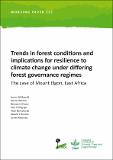| dc.description.abstract | Mount Elgon is a transboundary East African montane ecosystem that harbors unique biological diversity and provides critical goods and services to the surrounding densely populated communities. As a key water tower, the effectiveness of forest- and land-management policies has direct impacts on agriculture, hydropower, fisheries and other sectors across large watersheds in Uganda and Kenya (and onward to the whole Nile River basin). The Uganda Wildlife Authority (UWA), the Kenya Wildlife Service (KWS) and the Kenya Forest Service (KFS) have developed a range of exclusionary protected area and partial-access participatory forest management approaches to enforce national conservation mandates in different portions of the Mount Elgon. The future resilience of forest assemblages will be challenged as climate change and increased variability in weather patterns interact that with societal interventions that may enable the introduction of exotic species, the expansion of diseases. The objective of this study was to assess the impact of different forest governance regimes on forest structure and composition over time (1997-2014). Two study sites in Uganda (Kapkwai and Bufuma) and Kenya (Chorlem and Kimothon) under differing forest governance arrangements were monitored from 1997 to 2014 using the International Forestry Resources and Institutions (IFRI) methodology. Each forest unit was sampled three to four times (1997, 2001/2, 2008, 2013/14), at 30 randomly established sample plots. Data was collected on seedlings (counts), saplings and shrubs (diameter at breast height [DBH] and height), trees (DBH and height) and forest use. This analysis of forest structure and composition included density, basal area, dominant species, species richness and the Shannon-Wiener species diversity index. When comparing the outcomes for participatory forest management and centralized forest management in Uganda versus Kenya, the results defy dogmatic generalizations as the outcomes differed in the two countries. Furthermore, this study highlighted the fragility of certain improvements in forest resilience. In this respect, recent declines in forest cover mean that these forest management regimes will need to continue improving their engagement with local communities in order to address both internal socioeconomic and urban-/private sector-driven deterioration of Mount Elgon's forests. This study also highlights the need for greater integration of development (climate-change adaptation) and conservation (climate-change mitigation) policies. | en_US |

